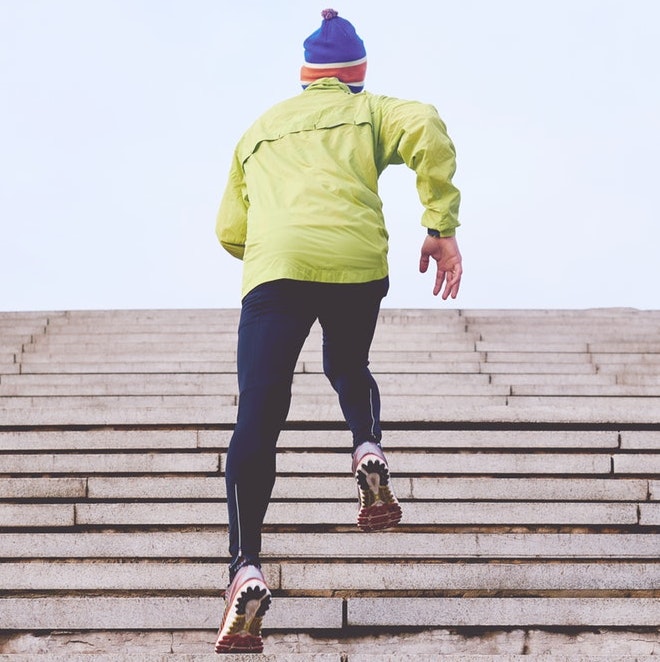If you get irritable pain and swelling in your knee while you run, you’re in good company. Thousands of runners suffer from what’s known as “runner’s knee” or “marathoner’s knee,” but the scientific name for this condition is patellofemoral pain syndrome, or, ITB Friction Syndrome.
The ITB, or the Iliotibial band, is a thick piece of fascia that comes down and attaches on the outside of the knee. There is a bursa, which is a little sack of fluid that deals with friction, that sits between the ITB and the actual knee. If there is too much tension on the ITB, it creates increased friction and irritates the bursa, which causes swelling and pain through the outside of the knee.
We spoke to Warwick Gordon, a fully licensed member of the ISCP (Irish Society of Chartered Physiotherapists) who currently practices as a Clinical Specialist in Musculoskeletal Physiotherapy at Run 360, to investigate why runner’s knee occurs, how to treat it, and how to prevent it.

What Causes Runner’s Knee?
Sometimes when people are experiencing the irritation of runner’s knee, they blame the problem on a “tight ITB,” which is actually not the source of the issue.
“Most people say ‘oh my ITB feels tight,’ which is a bit of a misnomer, because the ITB is a taut piece of fascia, that’s what its supposed to do,” says Gordon. “So, what you need to do is look higher up and see what is adaptively pulling on that ITB, which can be a little muscle in the front of your hip, called the Tensor Fascia Lata (TFL).”
“So what tends to happen is people are either too tight in their glutes or their gluteal muscles don’t always work appropriately, so they compensate by using their TFL in their hip to try to create the stability through their hip and pelvis … which isn’t a great idea because the TFL only inserts about 10% into the ITB where the gluteus maximus is inserting into 90% of the ITB,” says Gordon.
In many cases, runner’s knee occurs because there is weakness in the quadricep, gluteal, and lower back muscles. This weakness creates instability throughout the leg and can irritate the knee when faced with repetitive impact, like running.
“You have to look to your hips and your pelvis to make sure that you have adequate muscle and then appropriate strength and firing patterns between the muscles in your bum and the muscles in the front of your hip,” says Gordon.
Treatment and Prevention:
To treat the pain of patellofemoral pain syndrome, Gordon suggests, based on the level of pain, an anti-inflammatory and ice. Ice the knee for 10 to 15 minutes every two hours to reduce the swelling and irritation.
For long-term treatment and prevention, a combination of foam rolling, strength drills and stretching drills are recommended. The best way to prevent the onset of patellofemoral pain syndrome is to strengthen the muscles around the knee, i.e. the quadriceps, gluteal, and lower back muscles.
Although stationary drills such as laying on your side and lifting your leg up and down do indeed strengthen the hip muscles, try to progress isolated movements to a functional position.
Try standing with your back to a wall with one foot propped up against the wall, knee bent, and one foot firmly on the ground, leg straight. Make sure you have good posture throughout your back. With the leg that is on the ground, squat down about two inches and press back up. Do this about five times and then switch legs, rest, and repeat. This more functional movement will trigger all of the main muscle groups that contribute to the stabilization of your knee, instead of just isolating one.
Here are some more exercising you can do everyday to help treat runner’s knee:
Fire-Hydrants: On all fours, lift your knee up and out to the side, making sure your knee stays at a 45-degree angle, mimicking the motion of a dog urinating on a fire hydrant. Repeat this motion on each leg 15 times.
Clamshells: Lie on your right side and bend your knees at approximately a 45-degree angle. Keeping your feet together, slowly lift your left knee to “open up the clamshell.” Pause and then lower your knee to “shut the clamshell.” Repeat 15 times on each side.
Bridge-Up: Lie on your back with your knees bent and your feet flat on the floor. Slowly lift your glutes off the ground. Keep your back straight and lift “one vertebra at a time,” as in, make sure you can feel your spine slowly peel off of the floor.
Check out our Hard as Nails podcast:
Like this? Check out these other articles:










